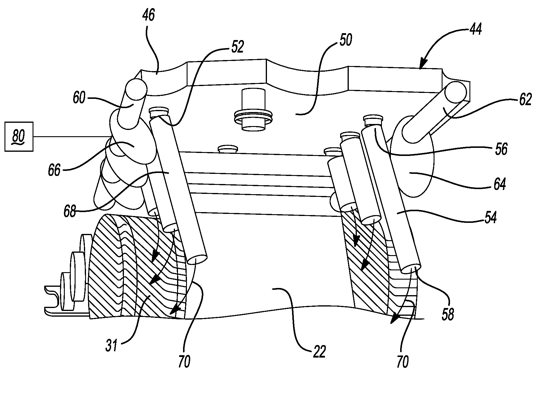| US 11,705,781 B2 | ||
| System and method of active end-turn cooling for an interior permanent magnet motor | ||
| Insu Chang, Troy, MI (US); SeungHwan Keum, Northville, MI (US); Jun-mo Kang, Ann Arbor, MI (US); and Young J. Kim, Troy, MI (US) | ||
| Assigned to GM GLOBAL TECHNOLOGY OPERATIONS LLC, Detroit, MI (US) | ||
| Filed by GM Global Technology Operations LLC, Detroit, MI (US) | ||
| Filed on Jul. 16, 2021, as Appl. No. 17/377,723. | ||
| Prior Publication US 2023/0020219 A1, Jan. 19, 2023 | ||
| Int. Cl. H02K 9/19 (2006.01); H02K 1/20 (2006.01); H02K 5/20 (2006.01); H02K 9/193 (2006.01) | ||
| CPC H02K 9/193 (2013.01) [H02K 1/20 (2013.01); H02K 5/203 (2021.01)] | 20 Claims |

|
1. A method of active end-turn cooling of an electric motor of a vehicle, the method comprising:
providing a motor comprising:
a rotary shaft connected to a rotor;
a stator unit comprising conductive windings arranged about the rotor, the windings having a straight portion radially extending to an end-turn portion having a target area;
an oil sump disposed above the stator unit, the oil sump comprising a reservoir having an inner side for containment of coolant and an outer side arranged above the end-turn portion, the reservoir having at least one aperture formed therethrough over the target area of the end-turn portion;
a movable nozzle having a first open end extending to a second open end, the first open end connected to the at least one aperture such that the movable nozzle and reservoir are in fluid communication, the second open end extending from the at least one aperture and positioned adjacently above the target area of the end turn portion for coolant distribution;
a cam being in movable contact with the moveable nozzle, the cam being moveably arranged to move the second open end of the nozzle over the target area of the end turn portion for distribution of coolant from the oil sump to the end turn portion;
measuring vehicle speed, vehicle lateral acceleration, and road tilt angle of coolant due to road tilt of the vehicle; if the speed of the vehicle is greater than zero, calculating coolant angle, coolant acceleration angle based on the lateral acceleration and the road tilt angle, the coolant angle being defined as a first angle of coolant drops at the end-turn relative to the second end; comparing the coolant angle with a critical angle being a maximum angle that coolant drops within the target area relative to the second end; if the coolant angle is greater than the critical angle, calculating a first control angle and a first coolant distance based on the road tilt angle and the lateral acceleration of the vehicle, the first coolant distance being a first distance of coolant drops relative to the target area due to road tilt angle and lateral acceleration; determining a cam position based on the first control angle, the cam position being a position at which the cam is arranged to move the second open end of the nozzle to compensate for the lateral acceleration of the vehicle such that the coolant drops within the target area of the end-turn; moving the cam to the position to move the second open end and compensate for the lateral acceleration of the vehicle such that the coolant drops within the target area of the end-turn. |